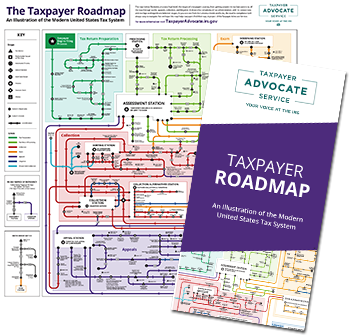Collection – Bankruptcy (Insolvency)
View our interactive tax map to see where you are in the tax process. It could help you navigate your way through the IRS.
View our interactive tax map to see where you are in the tax process. It could help you navigate your way through the IRS.

Proceedings begin when you file a petition in bankruptcy court; that filing creates the bankruptcy estate which consists of all your assets as of the filing date. When you file a bankruptcy petition your assets in the bankruptcy estate, under the jurisdiction of the bankruptcy court, aren’t subject to levy. However, creditors may file a “proof of claim” with the bankruptcy court to protect their rights. You should review Publication 908, Bankruptcy Tax Guide, prior to filing. Not all debts are dischargeable. Many tax debts are excepted from the bankruptcy discharge
The Bankruptcy Code generally refers to an insolvent entity (other than a partnership) as one with debts exceeding the fair market value of all of its property (see 11 U.S.C. § 101(32). You may use the Insolvency Worksheet on page 6 of Publication 4681, Canceled Debts, Foreclosures, Repossessions, and Abandonments, to determine if you are insolvent.
This notice or letter may include additional topics that have not yet been covered here. Please check back frequently for updates.
If you have a tax debt and you and/or your spouse filed a bankruptcy petition and may have received a bankruptcy discharge, then you may have received one of these letters. Please read the letter very carefully and respond accordingly. If you have any questions, please contact the person listed on the notice sent to you immediately.
You have unpaid debt which you cannot pay and have filed for bankruptcy or have been discharged after filing for bankruptcy. Other options include an IRS payment plan or an offer in compromise. See Publication 908, Bankruptcy Tax Guide.
The first thing to do is to check the return address to be sure it’s from the Internal Revenue Service (IRS) and not another agency.
If it’s from the IRS, the notice will have instructions on how to respond. If you want more details about your tax account, you can order a transcript.
If you owe past due federal taxes that you cannot pay, bankruptcy may be an option. Other options include an IRS payment plan or an offer in compromise.
If you have filed a bankruptcy petition, or you are a debtor’s attorney or a U.S. Trustee with questions about an open bankruptcy, you may contact the IRS’s Centralized Insolvency Operations Unit, Monday through Friday, 7 a.m. to 10 p.m. Eastern time, at ![]() 1-800-973-0424.
1-800-973-0424.
You should review Publication 908 prior to filing. Not all debts are dischargeable. Many tax debts are excepted from the bankruptcy discharge.
Understanding your notice or letter
For more specifics on your notice, visit Understanding your IRS Notice or Letter on IRS.gov
Get Help topics
Browse common tax issues and situations at TAS Get Help
If you still need help
The Taxpayer Advocate Service is an independent organization within the IRS that helps taxpayers and protects taxpayers’ rights. We can offer you help if your tax problem is causing a financial difficulty, you’ve tried and been unable to resolve your issue with the IRS, or you believe an IRS system, process, or procedure just isn’t working as it should. If you qualify for our assistance, which is always free, we will do everything possible to help you.
Visit dev.taxpayeradvocate.irs.gov or call ![]() 1-877-777-4778.
1-877-777-4778.
Low Income Taxpayer Clinics (LITCs) are independent from the IRS and TAS. LITCs represent individuals whose income is below a certain level and who need to resolve tax problems with the IRS. LITCs can represent taxpayers in audits, appeals, and tax collection disputes before the IRS and in court. In addition, LITCs can provide information about taxpayer rights and responsibilities in different languages for individuals who speak English as a second language. Services are offered for free or a small fee. For more information or to find an LITC near you, see the LITC page on the TAS website or Publication 4134, Low Income Taxpayer Clinic List.
Related Notices and Letters
Collection – Bankruptcy (Insolvency)